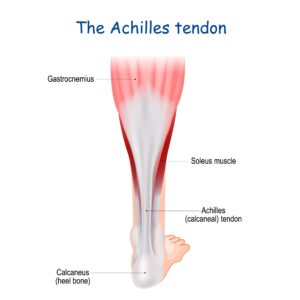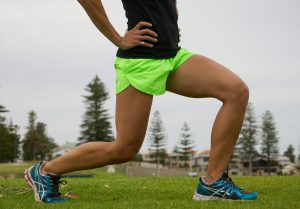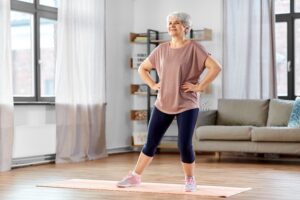Why strong calves are important

This article is in praise of your plantar flexors! Your plantar flexors are basically the muscles on the back of your leg beneath the knee that enable you to point your toes (plantar flexion). You should be grateful for your calves, without them you wouldn’t be able to move forward, stand up on your toes, go upstairs, or be able to wear stilettos. They are also crucial to protect you against various types of injuries and even to help your heart!
There are two main plantar flexors that make up the calves.
Gastrocnemius
With its two main compartments lying side by side this superficial muscle is the one which gives the back of the lower leg its distinctive shape. As well as being able to produce an extremely large contractile force at the ankle capable of propelling the body off the ground it is also a powerful flexor of the knee. However, it is not able to exert full power in both movements at the same time, when the knee is straight it can produce the necessary force to make you jump, and when the knee is bent it is better at flexing the knee (1).
Soleus
The soleus muscle is a much broader and deeper muscle to the gastrocnemius that provides up to 80% of the force of plantar flexion (2). This muscle does not cross the knee, with its highest point being the back of the fibula, further down the leg it becomes your Achilles tendon. The Soleus muscle is much more active when the knee is bent, when the knee is at 90 degrees nearly all plantarflexion is performed by the soleus (3). It is also incredibly important for when you are simply standing up as the line of gravity for the human body passes slightly in front of the ankle, this means that to stop you from falling forward the soleus must remain active.
There are several reasons why you should be taking care of your calves and several benefits that come from keeping them mobile and strong.
 Propulsion
Propulsion
If you want to move forward at speed, either running or walking, then the calf muscles are the main muscles involved in making this happen. Together they provide the vast majority (80%) of the forces needed to push you forward when the foot is in contact with the ground (4). This only changes when you get to sprinting speed where the majority of the propulsion force comes from the hips (5). If you happen to play a sport that involves sharp changes of direction then having a strong soleus is very important, this is because as you prepare to change direction you move your centre of gravity towards the ground (bending the hip, knee, and ankle). In this position, the soleus becomes much more active and plays a large part in stabilizing the knee and enabling the change of direction (6).
Protection from injury
Strong and supple calf muscles are important to help protect you against a litany of lower body conditions, mainly to do with the lower body. People who struggle with shin splints (medial tibial stress syndrome) are commonly found to have weak planar flexors, as well as tight gastrocnemius muscles, part of the rehabilitation program for this painful condition is to address these preexisting issues (7). If you are unfortunate enough to suffer plantar fasciitis then part of the reason why the condition appears in the first place is that the ankle and big toe is being stopped from flexing enough due to tight calves, which in the case of runners may also be too weak, resulting in an overload on the plantar fascia (8).
How your calves move and perform can also have an impact on knee injuries, as mentioned earlier a strong soleus will help stabilise the knee when the knee is bent, but the amount of movement the calves allow at the ankle also influences how the body lands after a jumping motion. Both of these factors are thought to influence the probability of cruciate ligament injuries in the knee (9, 10). Also, people who struggle with patella tendon pain often have tight calves that can lead to changes in how forces are transmitted through the knee (11).
Helping keep your heart healthy
Have you ever wondered how the blood gets from your legs back to your heart? A large part of how that happens is the contractile force exerted upon your veins by the calves when you walk. By way of gravity, when you go from a lying position to a standing one the blood pressure in your lower leg veins rises enormously, however when you begin to walk that large amount of blood is squeezed out of the lower leg by the calf muscles beginning it’s travel back to the heart. This pumping mechanism empties the veins by up to 80% (12), any stiffness in the calves, or a lack of movement in general can lessen this effect. Even though it seems far removed this pumping action by the calves is important in supplying enough blood to the heart to fill and stretch it before contraction to ensure the maximum amount of blood can be delivered by the heart using the least effort (cardiac preload) (13).
 Preventing falls
Preventing falls
As we get older losing balance and falling becomes more common and the resulting injuries, such as fractures, become more of a threat to our health (14). Elderly people can fall for many reasons including effects of medication, visual changes, and dizziness associated with heart problems. One of the biggest reasons people fall is muscle weakness, especially weakness in the lower limbs (15). The good news here is that a program of lower limb strengthening has been shown to be very effective in improving balance and coordination, and importantly reducing falls. Elderly people who wish to reduce falls should, as well as having their medication reviewed and limiting hazards in their home, include exercises that will increase the strength in their calf muscles.
Are you struggling with tight calves or keep getting repetitive lower leg or foot injuries? Visit our resources page for a basic calf care guide.
Why not take advantage of our new patient assessment introductory offer to get you started towards a tailor-made recovery plan for only £19.
Are you in a lot of pain and want to get better as soon as possible? If so then why not book in for a new patient consultation, with treatment on the day, for £75.
References
1 – Bordoni B, Varacallo M. Anatomy, Bony Pelvis and Lower Limb, Gastrocnemius Muscle. [Updated 2023 Apr 17]. In: StatPearls [Internet]. Treasure Island (FL): StatPearls Publishing; 2023 Jan-. Available from: https://www.ncbi.nlm.nih.gov/books/NBK532946/
2 – Fukunaga T, Roy RR, Shellock FG, Hodgson JA, Day MK, Lee PL, et al. Physiological cross-sectional area of human leg muscles based on magnetic resonance imaging. J Orthop Res. 1992;10(6):928–34.
3 – Nardone A, Romanò C, Schieppati M. Selective recruitment of high-threshold human motor units during voluntary isotonic lengthening of active muscles. J Physiol. 1989;409(1):451–71.
4 – Hamner SR, Seth A, Delp SL. Muscle contributions to propulsion and support during running. J Biomech. 2010;43(14):2709-2716. doi:10.1016/j.jbiomech.2010.06.025
5 – Dorn, T.W., Schache, A. G., and Pandy, M.G. “Muscular strategy shift in human running: dependence of running speed on hip and ankle muscle performance.” The Journal of Experimental Biology. 2012; 215(11); 1944–1956.
6 – Neumann, D.A. (2010). Kinesiology of the Musculoskeletal System: Foundations for Rehabilitation. Mosby/Elsevier.
7 – Dugan S, Weber K. Stress fracture and rehabilitation. Phys Med Rehabil Clin N Am. 2007;18(3):401–416.
8 – van Leeuwen, B. Rogers, J. Winzenberg, T. et al (2016). Higher body mass index is associated with plantar fasciopathy/‘plantar fasciitis’: systematic review and meta-analysis of various clinical and imaging risk factors Br J Sports Med;50:972-981.
9 – Malloy P, Morgan A, Meinerz C, Geiser C, Kipp K. The association of dorsiflexion flexibility on knee kinematics and kinetics during a drop vertical jump in healthy female athletes. Knee Surg Sports Traumatol Arthrosc. 2015;23(12):3550-3555. doi:10.1007/s00167-014-3222-z
10 – Myer, G.D., Ford, K.R., Khoury, J., Succop, P., and Hewett, T.E. “Development and Validation of a Clinic-Based Prediction Tool to Identify Female Athletes at High Risk for Anterior Cruciate Ligament Injury.” The American Journal of Sports Medicine. 2010; 38(10): 2025–2033.
11 – Willy RW, Hoglund LT, Barton CJ, Bolgla LA, Scalzitti DA, Logerstedt DS, Lynch AD, Snyder-Mackler L, McDonough CM, Altman R, Beattie P. Patellofemoral pain: clinical practice guidelines linked to the international classification of functioning, disability and health from the academy of orthopaedic physical therapy of the American physical therapy association. Journal of Orthopaedic & Sports Physical Therapy. 2019 Sep;49(9):CPG1-95.
12 – Venous pressure in the saphenous vein at the ankle in man during exercise and change in posture. J Appl Physiol. 1949; 1: 649-652
13 – O’Keefe E, Singh P. Physiology, Cardiac Preload. [Updated 2022 Sep 26]. In: StatPearls [Internet]. Treasure Island (FL): StatPearls Publishing; 2023 Jan-. Available from: https://www.ncbi.nlm.nih.gov/books/NBK541109/
14 – Keene GS, Parker MJ, Pryor GA. Mortality and morbidity after hip fractures. BMJ 1993;307(6914):1248-50.
15 – Ishigaki EY, Ramos LG, Carvalho ES, Lunardi AC. Effectiveness of muscle strengthening and description of protocols for preventing falls in the elderly: a systematic review. Braz J Phys Ther. 2014;18(2):111-118. doi:10.1590/s1413-35552012005000148


 Propulsion
Propulsion
 Preventing falls
Preventing falls